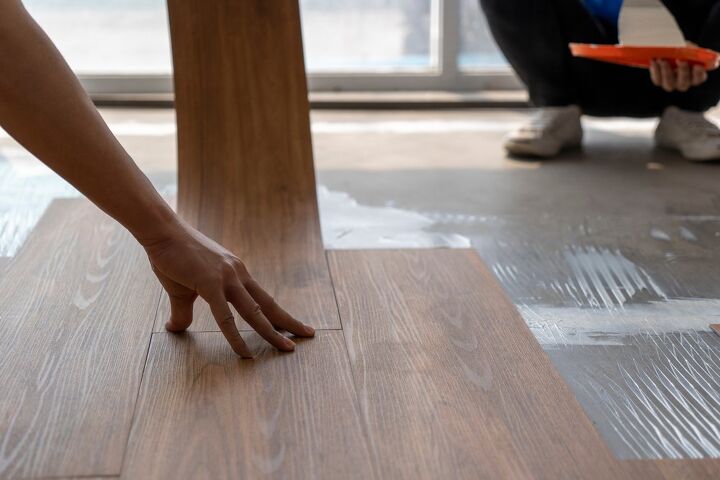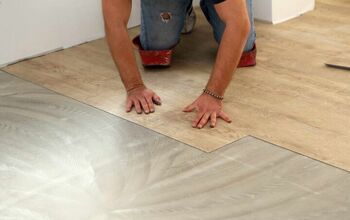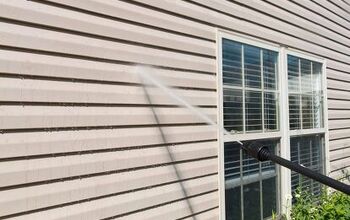How To Remove Glue From Vinyl Flooring

For many homes, vinyl flooring is a fantastic alternative. It is elegant, enduring, and simple to clean. However, any adhesive that was used during installation might still be visible. It is simple to remove the adhesive from vinyl flooring without harming the surface, but you must know how to do it right.
Using acetone to soften the glue and scrape it away is the most effective method for removing glue from vinyl flooring. Wait a few minutes as the acetone dissolves the binding after being sprayed straight onto the adhesive. Next, use a scraper to horizontally push the adhesive away.
You can find detailed directions on how to take glue off vinyl flooring in this post. Additionally, you will learn how the type of glue impacts how to remove it, how long glue takes to dry, how to clean vinyl flooring after removing glue, and some things to keep in mind.
What Removes Glue from Vinyl Flooring?
The remedy can be acetone-based nail polish remover or floor stripper. Chemicals like acetone aid in removing the adhesive.
Even mineral spirits have been utilized by some homeowners to help with cleanup. spritz the ground: Spray some of your stripping solution onto the adhesive you wish to get rid of after placing it in a spray bottle with a nozzle. Glue from Vinyl Flooring: How to Remove It
Glue can be unsightly on vinyl flooring, but after installing vinyl flooring, you probably have some on the surface. As long as you know how to remove the glue from the flooring, this is not a major concern.
Your new, fashionable flooring will no longer have those imperfections if the extra glue is removed correctly and without harming the vinyl.
Step 1: Prepare Your Body and Space
Grab a pair of gloves. This will shield the skin from acetone or glue-related discomfort. It is also a good idea to use a protective face covering or mask if you are not dissolving glue in a well-ventilated location.
To make it simpler to squirt the acetone straight onto the adhesive, put it into the squirt bottle. It is significantly simpler to manage the acetone application when using a squirt bottle.
You can create your own squirt bottle if you don’t already have one by making a few tiny holes in the cap of an ordinary plastic water bottle.
If you don’t have acetone nail polish at home, you can also try vinegar, rubbing alcohol, or degreasing soap. Acetone is the most efficient household solution for dissolving glue, though.
These compounds work better for delicate cleaning, but in some cases they can also remove glue. For removing adhesive from vinyl flooring, there are various products available in stores, such as Goo Gone.
Step 2: Test the Acetone
You should test the acetone in an area where it won’t be seen before spraying it on your floor. This will guarantee that it won’t damage the floor or alter its color.
Following a test, you can spray acetone directly onto the glue to break the link between the adhesive and the flooring.
You can also put the acetone on a rag or piece of cloth to apply to the glue in tight spaces like corners or other difficult-to-reach areas of the room without getting any acetone on the walls. You will need to wait a few minutes after applying the acetone for it to sufficiently remove the adhesive.
Step 3: Scrape Off the Glue
You can start working on removing the adhesive once it has been sufficiently loosened. Without applying pressure, scrape the glue to the side using the scraper.
To move the glue from its initial position, the motion must be parallel to the floor. You might need to repeat this process if the glue is particularly thick.
Step 4: Wipe Away Remnants
Use a sponge or rag to wipe away any particles and leftover glue after you have completely removed it. Additionally, this will remove any acetone that might still be on your vinyl flooring.
After learning how to remove glue from vinyl flooring, it is a good idea to consider other variables that might affect these actions.
What Variables Should You Consider When Removing Vinyl Glue?
There are many different variables that play into removing vinyl glue. Below, we will talk about what those are.
Fresh Glue
You can save time later on by removing the glue while it is still wet. It is very simple to complete while you are still installing the vinyl flooring.
Just be sure to keep an eye on your work and any areas where glue drips into the flooring or seeps to the surface.
To remove the adhesive, wipe it with a moistened cloth or sponge. The glue may need to be scraped onto a scraper if there is too much to completely remove with a cloth or sponge. This will enable you to simply remove the extra amounts, leaving only a minimal amount to clean.
Floor Seams
The most likely location for glue to leak onto the surface is in the flooring’s seams. Due to the possibility of glue remaining on the subfloor after the vinyl has been laid, this is also a worry for flooring projects that take more than a day.
You’ll need a wooden board with a straight edge to remove this glue. This will smooth out any extra glue that may stick out from the seam.
It will then be evened out and put into the seam, making it invisible. The crevice shouldn’t have any more glue than the other seams in the room combined.
Doing this while the glue is still wet can save you more work the next day when it dries. If your project takes more than a day, make sure you get rid of excess glue so that you do not have to go through the process of removing it when it is dried the next day.
Dried Glue
The adhesive will be more challenging to remove once it has dried. Before removing it with a scraper, you must first loosen it using a solvent solution (as described earlier). There are a few other things to think about.
Typically, vinyl glue will dry transparently and remove without breaking. If the glue is thick enough, you might be able to remove it in one piece without using acetone by scraping it off with a putty knife or scraper.
If so, all that is required to remove any lingering remnants from the floor is to clean them up with a damp cloth or sponge.
Another possibility is cement or solvent-based adhesive. You should be able to get some of it off without using a solvent, although there might still be some adhesive residue.
To apply the acetone uniformly and successfully loosen the glue for very thin areas, use a paintbrush. This will also work with glue that was previously removed and cleaned up but had been present for a long time.
Will Acetone Damage Vinyl Flooring?
Before using acetone to remove the glue, you should always consider the type of vinyl flooring and manufacturer guidelines because acetone has the potential to harm vinyl flooring. Additionally, try the acetone first on a tiny, inconspicuous area of the floor.
Because acetone evaporates so quickly, the floor is unlikely to sustain significant harm. Just be careful not to keep it on the flooring for any longer than necessary because it could disintegrate the vinyl base or taint the vinyl. However, a lot of vinyl floors can withstand a little for a short while.
Is Goo Gone Safe on Vinyl Flooring?
Goo Gone Original is surface safe and can be used on carpet, upholstery, clothing, and any hard surface, including ceramic, granite, flooring, worktops, metal, laminate, wood, plastic, and vinyl.
Is Goof Off and Goo Gone the Same Thing?
The main distinction between Goo Gone and Goof Off is that the former uses a moderate citrus basis while the latter uses a strong acetone base.
Goof Off is better suited for tough messes like tar, dried paint, and glue, while Goo Gone works best for removing residue from stickers and tape.
How Do I Remove Adhesive Residue?
Canola or vegetable oil, as well as peanut butter or mayonnaise, are all excellent options. Spread it on, give it about an hour to absorb into the residue, and then wipe it off.
Try vodka or rubbing alcohol for a more robust clean. Allow it to thoroughly penetrate the undesirable residue before using a cloth to scrub it away.
Does Vinegar Remove Sticky Residue?
You may save money by learning how to remove sticker residue using common household materials. Lay a rag or paper towel across the sticky area after soaking it in vinegar.
After letting the residue soften for a few minutes, wipe or scrape the residue off. Additionally, vinegar can be used to clean your entire house.
Can Baking Soda Remove Sticky Residue?
Baking soda is a fantastic option for eliminating sticker residue in kitchen settings because it is non-toxic and acceptable for use in restaurants.
Mix equal amounts baking soda and frying oil to create a paste. Apply the paste to the label, let it sit for about five minutes, and then wipe it

Heather is a passionate writer who loves anything DIY. Growing up, she learned everything from home repairs to design, and wants to share her tips with you. When she's not writing, she's usually hiking or searching for her next DIY project.
More by Heather Robbins



























